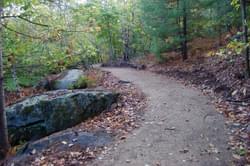




A sustainable trails that complies with the trail accessibility guidelines without changing the setting or outdoor experience.
by Peter S. Jensen, Trail Planner/Builder, Peter S. Jensen & Associates

At Crotched Mountain in Greenfield, New Hampshire, sustainable trails are also accessible trails. The Crotched Mountain Foundation’s new trail system was designed and built to the proposed federal trail accessibility guidelines and was official opened in June 2011.
The trail system is fully accessible, ranging from a wetland loop at the lowest point to a stunning vista at the summit of a knoll 300 feet above. The entire trail is perched on the southerly side of Crotched Mountain with views of Mt. Monadnock.
The trail system provides a total of 3.6 miles of pedestrian recreation through lowbush blueberry fields, pine forests, dense hardwoods, meadows, and wetlands. It provides a thorough visual explanation of the morphology of this part of southwestern New Hampshire.
Construction of these trails was accomplished over a four-year period using native materials for the stone trail structures and the trail surfacing. Bridges and boardwalks were constructed of imported materials. The majority of the trail system is a 5 foot wide treadway. Other sections are 4 feet wide and 3 foot wide. A combination of machine built and hand built trail exists on the property.
This sustainable trail system has become the focal point for training workshops on trail development using the proposed federal trail accessibility guidelines.
For more information on the trails at Crotched Mountain please visit www.crotchedmountain.org.
Building a Permeable, Low Maintenance Recreational Trail Along a Shoreline
posted Apr 7, 2023
In 2009, the city of The Colony planned to build a recreational trail (10 foot-wide, 3.5 mile pathway) that would run along the lake’s shoreline, contouring to its natural shape and providing residents with a picturesque route for outdoor activities such as walking, jogging, and cycling. The city selected the GEOWEB® Soil Stabilization System due to its flexibility to conform to curves, surface permeability, and low maintenance design.
posted Jul 15, 2022
This research investigated the influence of several use-related, environmental, and managerial factors on soil loss on recreational trails and roads at Big South Fork National River and Recreation Area, a unit of the U.S. National Park Service.
All-Terrain Vehicle Sustainability Assessments
posted Jul 15, 2022
The sustainable management of ATV use is an expensive proposition requiring careful design, construction, and maintenance of ATV trails.
posted Jul 15, 2022
This research assessed the condition and sustainability of the trail system at Tallgrass Prairie National Preserve, a National Park Service unit that partners with The Nature Conservancy (TNC) in the management of this unit.
1,326 views • posted 04/03/2018